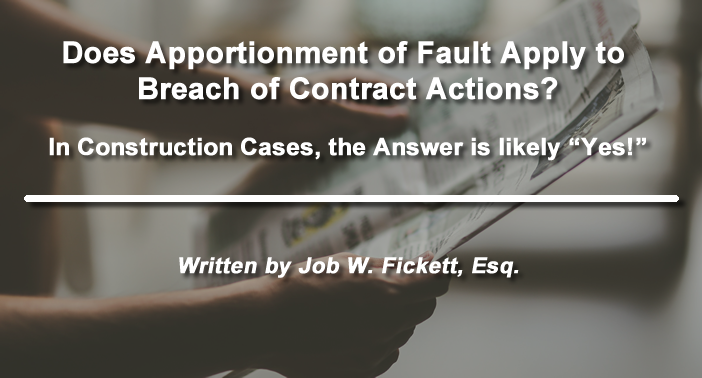As a standard practice, defendants of third-party claims in construction defect litigation should strongly consider asserting affirmative defenses traditionally applicable to negligence, even if party is only sued in theories of recovery that sound in contractual liability. This is especially true when the defendant/third-party plaintiff was sued for negligence in the first party action, regardless of whether those negligence causes of action were explicitly “passed through” to the third-party defendant.
At the same time, attorneys representing general contractors should be cognizant that by pleading only contractual claims against subcontractors, those claims may still be subject to apportionment, Fabre, and comparative fault defenses under Florida Statutes Sections 768.71 and 768.81, and the recent decision of Broward County v. CH2M Hill, Inc., et al., (Fla. 4th DCA 2020). [https://law.justia.com/cases/florida/fourth-district-court-of-appeal/2020/18-3401.html] In Broward Cty., the Fourth DCA held that apportionment of damages is appropriate in construction matters, even where the claim is for breach of contract.
Recently, our firm litigated a matter in which the general contractor was sued by the homeowners’ association for negligence, breach of warranty, and violation of the Florida Building Code. In turn, the general contractor brought third-party causes of action for contractual indemnity and breach of contract as to each subcontractor. The subcontractors contractually agreed that they would be indemnify the general contractor for any damage proven to be caused, “in whole or in part,” by their work. The general contractor intended for language to be a contractual agreement to be jointly and severally liable, despite the statutory abolition of common law joint and several liability in Florida. The subcontractors uniformly asserted affirmative defenses pertaining to apportionment of fault.
Before trial, the general contractor moved for summary judgment on these affirmative defenses, among others. The subcontractors opposed the motions and filed their own requesting the court to mandate apportionment of fault among all defendants (both first- and third-party) on the jury verdict form. The subcontractors argued that the language of Sections 768.71 and 768.81, as interpreted by the court in Broward Cty., superseded the “in whole or in part” language in the indemnification provision of the subcontracts. They also argued that the substance of the allegations against them, despite being plead as breaches of their contracts, were actually claims for negligence (i.e., if the homeowners’ association’s claims against the general contractor for negligence were true, it implied that the negligent work of the subcontractors was the impetus for breaches of their contracts, and therefore they should be entitled to have the jury apportion fault among them). The general contractor wanted a single allocation of fault against all first-party defendants (the developer and waterproofing consultant were also sued by the homeowners’ association) that it could then enforce the amount of fault apportioned to the general contractor, if any, jointly and severally among the subcontractors pursuant to the “in whole or in part” indemnification language.
Ultimately, the court sided with the subcontractors, relying upon the Broward Cty. decision. In Broward Cty., the Court of Appeals specifically affirmed that Part II of Chapter 768, Florida Statutes, applies to any action for damages, whether couched in tort or contract. Further, the Court of Appeals noted that, although § 768.81(3), Florida Statutes, requires apportionment of damages in “negligence” actions, negligence is defined in the statute as:
“. . . without limitation, a civil action for damages based upon a theory of negligence, strict liability, products liability, professional malpractice whether couched in terms of contract or tort, or breach of warranty and like theories. The substance of an action, not conclusory terms used by a party, determines whether an action is a negligence action.”
§ 768.81(1), Florida Statutes (emphasis added).
This application of Broward Cty. effectively rendered the contractual agreement for joint and several liability moot. The court held that the “in whole or in part” language was not “sufficiently unambiguous to require joint and several liability.” The implication in the court’s ruling was that more specific language may have been enough to overcome the common law abrogation, but in any event, it is not clear that the court would have enforced the provision anyway. By holding that Broward Cty. was directly on point, it appears that apportionment of fault—even in contract actions that imply or “pass through” negligence—is now the law of the land in Florida. Attorneys representing subcontractors should err on the side of asserting these affirmative defenses traditionally applied to negligence causes of action because the case law provides a sufficient good faith basis for doing so. When advising general contractors on their subcontract agreements, it would be wise to emphasize the actual words “joint and several liability” appear in context if the intention is to have indemnification provisions broadly require subcontractors to indemnify for the entire amount of damages, rather than their proportional share. Even still, under the Broward Cty. case, that may not be enough, and litigation should be strategized accordingly.


